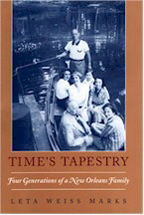
176 pages / 5.50 x 8.50 inches / 25 halftones
History / United States - Southern History
“No other Jewish community in the country is quite like New Orleans. Leta Marks, a native daughter, writes about it with rare detachment: about its desire to fit in, its fitful protests against injustice, its civilized charms and graces. Marks also paints a moving portrait of her parents, especially her father, Huey’s architect. At times Time’s Tapestry seems like a reprise on All the King’s Men, except the tragic downfall happens to one of the men, too.”—Lawrence N. Powell, Tulane University
More than forty years after leaving her native New Orleans as a bride, Leta Weiss Marks awakened to the realization that her past was fast slipping away. Rescuing it, for herself and posterity, became her mission and brought her home again. In this compelling, elegant blend of fact and fiction, Marks weaves a tapestry of her family members and events, drawing mainly upon interviews with her nonagenarian mother and aunt. Letters, archival research, and Marks’s own recollections and imagination also contribute to the composition, which she calls “a song of myself and my family.”
At the center are Marks’s mother and father, and the highs and lows of their courtship and marriage. Caroline Dreyfous was born into a prominent Jewish family of New Orleans; Leon Weiss, seventeen years her senior, always struggled to gain their acceptance. He was an ambitious, talented architect, the driving force in the famous firm of Weiss, Dreyfous and Seiferth, and chosen by Huey Long to design the new state capitol and governor’s mansion, and New Orleans’ Charity Hospital, among other landmarks. He also was implicated in the “Louisiana Scandals” and sentenced to two years in federal prison. Time’s Tapestry is in part Marks’s attempt to peel back her mother’s unwavering, reticent loyalty toward her father and understand this man, who died when Marks was only twenty-one and preparing to move to Connecticut.
Stories and memories of three generations of the Dreyfous branch of the family tree round out Marks’s portrait. She makes vivid not only the personalities of her kin but also the social and historical contexts of their lives. She conjures the New Orleans of her great-grandfather, grandparents, parents, and own childhood and juxtaposes those scenes with her experiences as an adult returning to visit her family in a greatly changed New Orleans. Both an intimate family album and a priceless record of New Orleans’ cultural, social, and political history, Time’s Tapestry will charm anyone who treasures the past.
Found an Error? Tell us about it.